- The Case for Brand
- Posts
- 📈 How Southwest Airlines Built an Iconic Low-Cost Brand—and Why Their Latest Move To Layoff Workers & Cut the 'Bags Fly Free' Policy Could Erode It
📈 How Southwest Airlines Built an Iconic Low-Cost Brand—and Why Their Latest Move To Layoff Workers & Cut the 'Bags Fly Free' Policy Could Erode It
Where peanuts were free and the attitude was, too
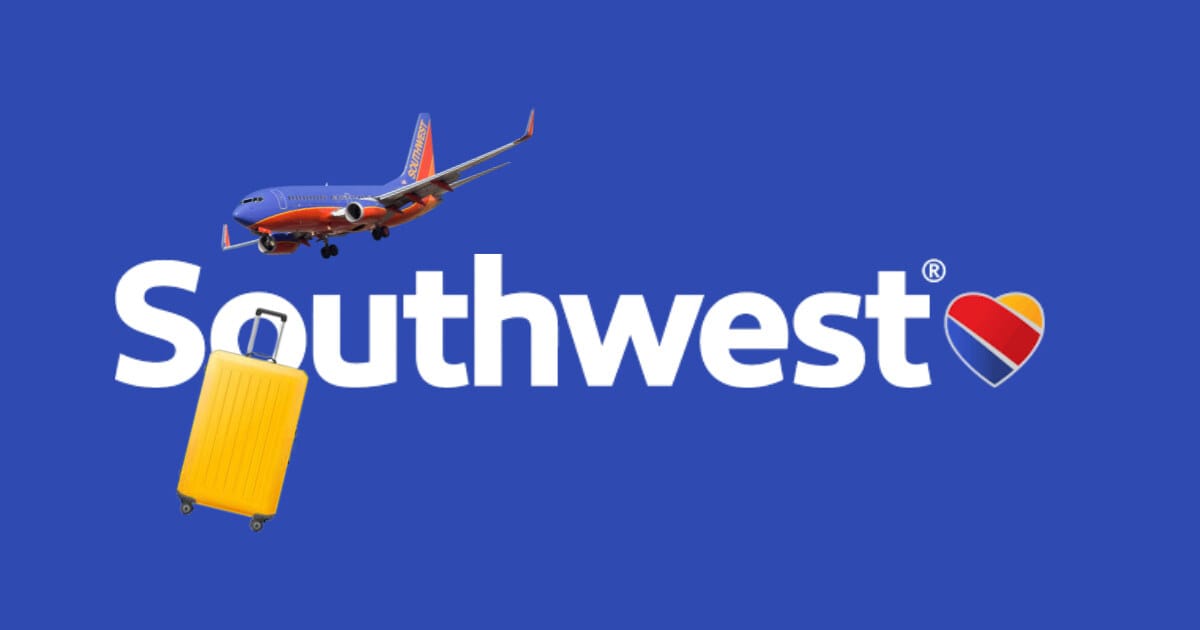
👋 Hi, I'm Amanda. I'm a brand strategist and fractional CMO. I help founder-led businesses turn belief into brand—and brand into a strategic asset that works as hard as you do. I share weekly deep dives with actionable advice on brand building—plus interviews with the people in the trenches. I also work 1:1 with founders and teams. Book a chat here.
Who Will Love This
Herb Kelleher stans
My dad
Aviation nerds
Sustainable growth advocates
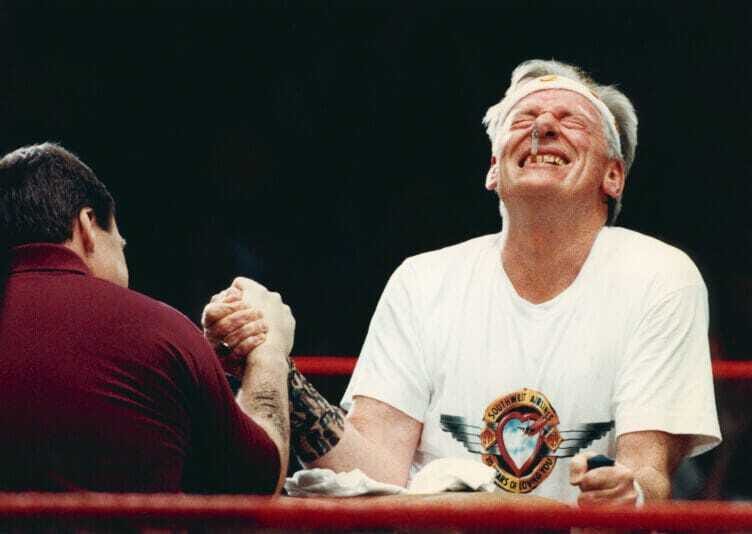
Southwest Airlines is shifting away from its low-cost roots under investor pressure—cutting free bags, adding premium seating, and tweaking its model. Now boarding: a front-row seat to the risks of short-term thinking on a brand built from the inside out.
Today
Happy Friday.
Something I’ve been reflecting on this week: the impact of leadership on a business, the challenge of sticking to your principles in tough times, and how brand erodes when short-term thinking takes over.
Today’s letter is about Southwest Airlines cutting their ‘bags fly free’ policy. But it’s bigger than that! This week, I’m writing about the airline industry, and how much it’s changed—not just in glamour but in access. Air travel used to be for the elite. Southwest Airlines changed that. Co-Founder and CEO Herb Kelleher’s vision of making air travel affordable for all reshaped the industry. Under his 20-year tenure as CEO, Southwest was a case study in how a brand can be a true business moat.
But today, that brand is at a crossroads. In the last eight months, Southwest have:
🎟️ Cut free-for-all boarding in favor of assigned seats
🧳 Eliminated free checked bags
💺 Shifted away from a single-class offering, announcing plans to add seats with more legroom.
👫 Cut 15% of their total workforce, breaking a 54 year streak of no furloughs
It might sound silly but reading about all of this makes me feel incredibly disappointed: cutting the very things that made Southwest a standout brand has a short and long term impact that’s hard to quantify. The New York Times recently ran a piece titled How Southwest Airlines Lost Its Groove. We may be witnessing, in real time, the erosion of a once-iconic brand.
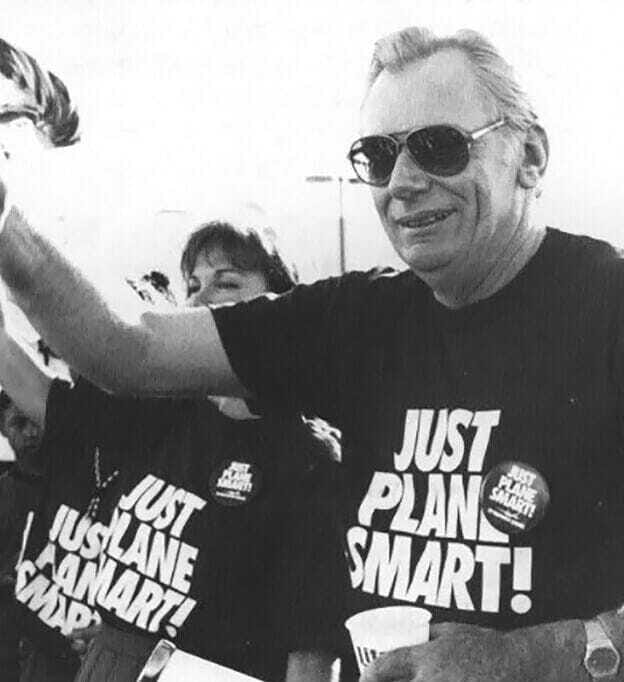
What’s driving the change from long-term thinking to short-termism?
If you guessed private equity, ding-ding-ding, you are correct. Elliott Investment Management’s stake in the company was revealed in May 2023, and they now own enough of the company to call special meetings.
Southwest is under pressure from activist investors at Elliott Investment Management, who have been pushing for changes in management and growth in profitability. Southwest reported a 51% drop in adjusted profit last quarter, despite hitting record revenue. But activist pressure did not factor into the company’s move to assigned seats, Southwest CEO Bob Jordan said on the earnings call (mmmk, sure Bob).
People aren’t happy (of course) which is a m-a-j-o-r shift for Southwest.
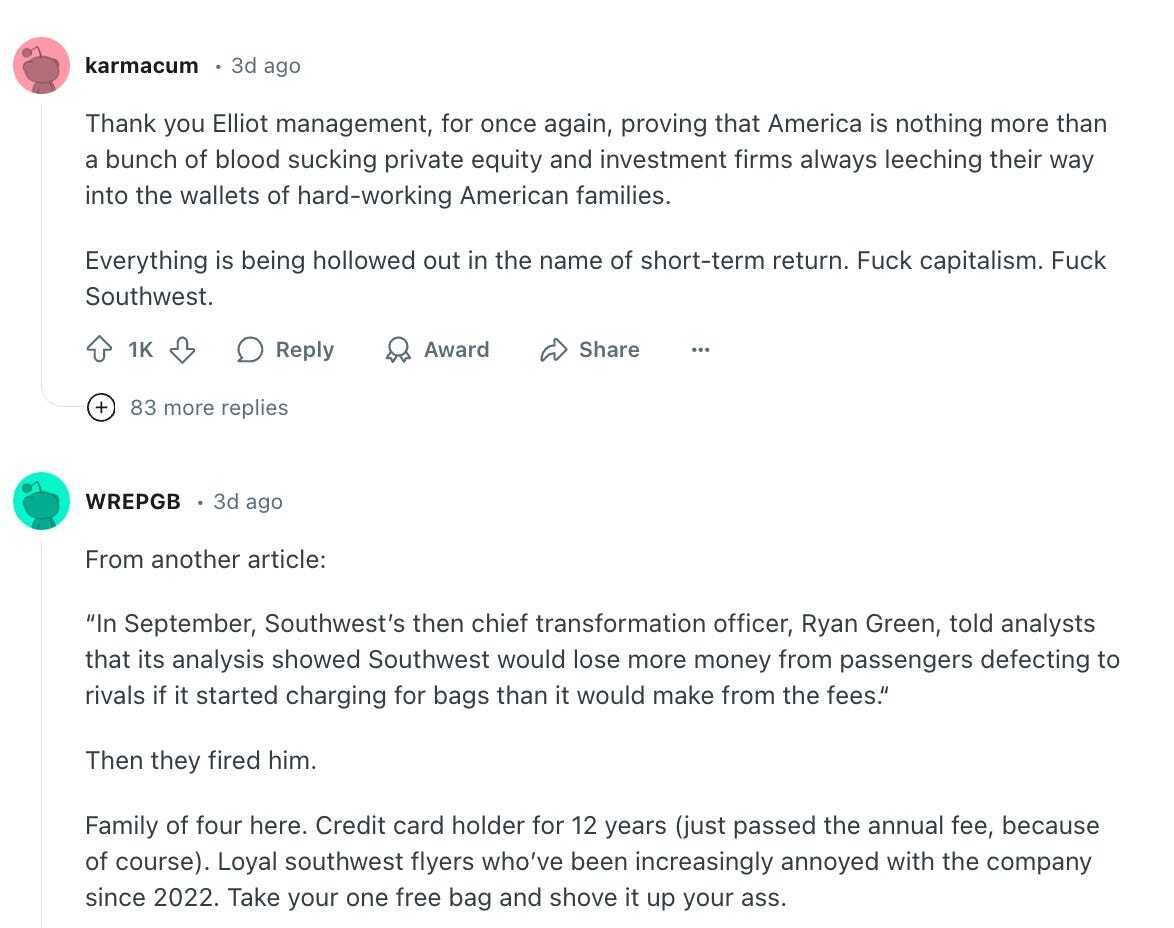
Southwest has also been facing competition from major carriers—American, United, and Delta—who drive revenue through premium seating. At the same time, it’s under pressure from ultra-low-cost carriers like Spirit (who filed for bankruptcy in November) and Frontier, which lure budget travelers with bargain-priced seats but charge extra for everything from carry-ons to seat selection.
Today we’ll take a look at Southwest’s business and brand strategy to date.
Fasten your seatbelts ✈️
Amanda
Business Strategy: The No-Frills, High-Profit Playbook
The aviation business is hard. So hard that after legendary investor Warren Buffett lost $50B investing in them in 2016, he sold them off in 2020 (and swore them off), calling them a “very unpleasant experience.” Yikes.
Why are most airlines unprofitable?
Before the late 1970s, the airline industry was heavily regulated. There were just a handful of big carriers, and government officials essentially controlled the routes they could fly and the fares they could charge. Then in 1978, the Airline Deregulation Act changed all that.
Some of those older carriers, like Pan Am, couldn’t keep up and eventually went bankrupt or merged with others. Many of the smaller, upstart airlines of the 1980s didn’t last long either. Running an airline involves a lot of guesswork—airlines have to commit to flights, seats, and pricing before they know what demand will actually look like. As Clifford Winston, a senior fellow at the Brookings Institution, put it, “They’re caught holding the bag” if an unexpected event—like a recession or a fuel price spike—hits the industry.
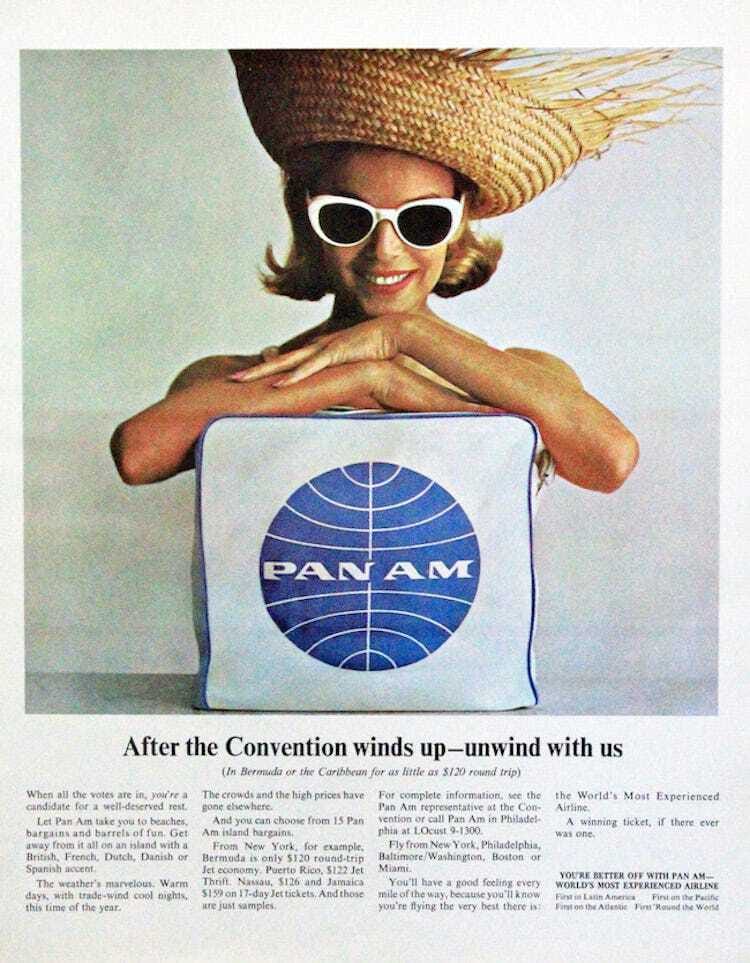
That’s part of what led to another rash of airline bankruptcies in the mid-2000s. The September 11th attacks scared away passengers for a while, and around the same time, a new wave of low-cost airlines, including Southwest, began gaining traction. These carriers reshaped the industry again, doubling down on efficiency and simplicity. But today, even the most disciplined airlines aren’t immune to economic pressures and shifting investor priorities.
How Southwest nailed 47 straight YEARS of profitability
Southwest had an extraordinary streak of profitability and a no-furlough policy that is unrivalled in the airline industry. How? Southwest ran a tight ship (or, well, a tight fleet of only Boeing 737s, which simplified maintenance and training). Some of their legendary cost-saving moves:
One aircraft type = cheaper maintenance & training.
No assigned seats = faster boarding.
Only secondary airports = fewer delays.
Cut three nuts from each bag of peanuts = saved $300,000 per year.
Their philosophy was simple: keep costs low, keep service high, and never, ever charge for baggage. Until now.
Brand Strategy: Fun-LUVing, Fiercely Independent, Relentlessly Disciplined
Good brand strategy is the things you must do consistently, and well, to hold the position you want to in your audience’s mind. Southwest has been built on three core pillars:
1️⃣ Great Service.
Southwest took care of people: both employees and customers.
The flight experience was consistent, friendly, and easy.
2️⃣ A Fun-LUVing Attitude.
The airline didn’t take itself too seriously. Kelleher once settled a corporate slogan dispute via an arm-wrestling match—dubbed “Malice in Dallas.”
Their TV ads featured Kelleher in a paper bag, poking fun at competitors who dismissed them as a “cattle car.”
Flight attendants rapping the safety briefing became legendary.
3️⃣ Serious Discipline.
Low fares, high efficiency, no nonsense.
Never chased market share for its own sake—just profitability.
“We take our competition seriously, but not ourselves.” - Herb Kelleher
Brand Marketing Moves
Normally I dig around for very recent marketing moves from brands, but I think in this instance it’s helpful to look at some of the more iconic challenger brand moments that built Southwest’s brand, highlighted their people, and leaned into being a low cost carrier.
✈️ “Malice in Dallas” - A Masterclass in PR Stunts. When a small aviation company sued Southwest over a slogan, Kelleher proposed they settle it not in court, but with an arm-wrestling match. He lost—but the stunt generated massive press, and the competitor let them keep the slogan.
🎥 The Paper Bag Campaign. This is an oldie but a goodie. As Southwest expanded to new cities, some industry executives and passengers dismissed it as a “cattle-car operation” for cheap travelers. Kelleher’s response? A TV commercial in which he wore a paper bag over his head and offered it to any passenger too embarrassed to be seen flying Southwest. Watch it here.
🎤 Flight Attendants as Entertainers. Southwest encouraged employees to have fun, resulting in viral moments like flight attendants rapping safety briefings or cracking jokes over the PA. Can you imagine this happening on a Delta flight?
🎫 Internal Brand Building - The Leadership Mug. K guys this is a real scoop straight out of my parents kitchen. I think my dad went to a leadership conference put on by Southwest. Brand building and internal comms can border on propaganda, but at its best, it serves as a daily reminder that putting a brand into your people’s hands is about setting expectations, telling stories, and empowering employees to build the brand from the inside out.
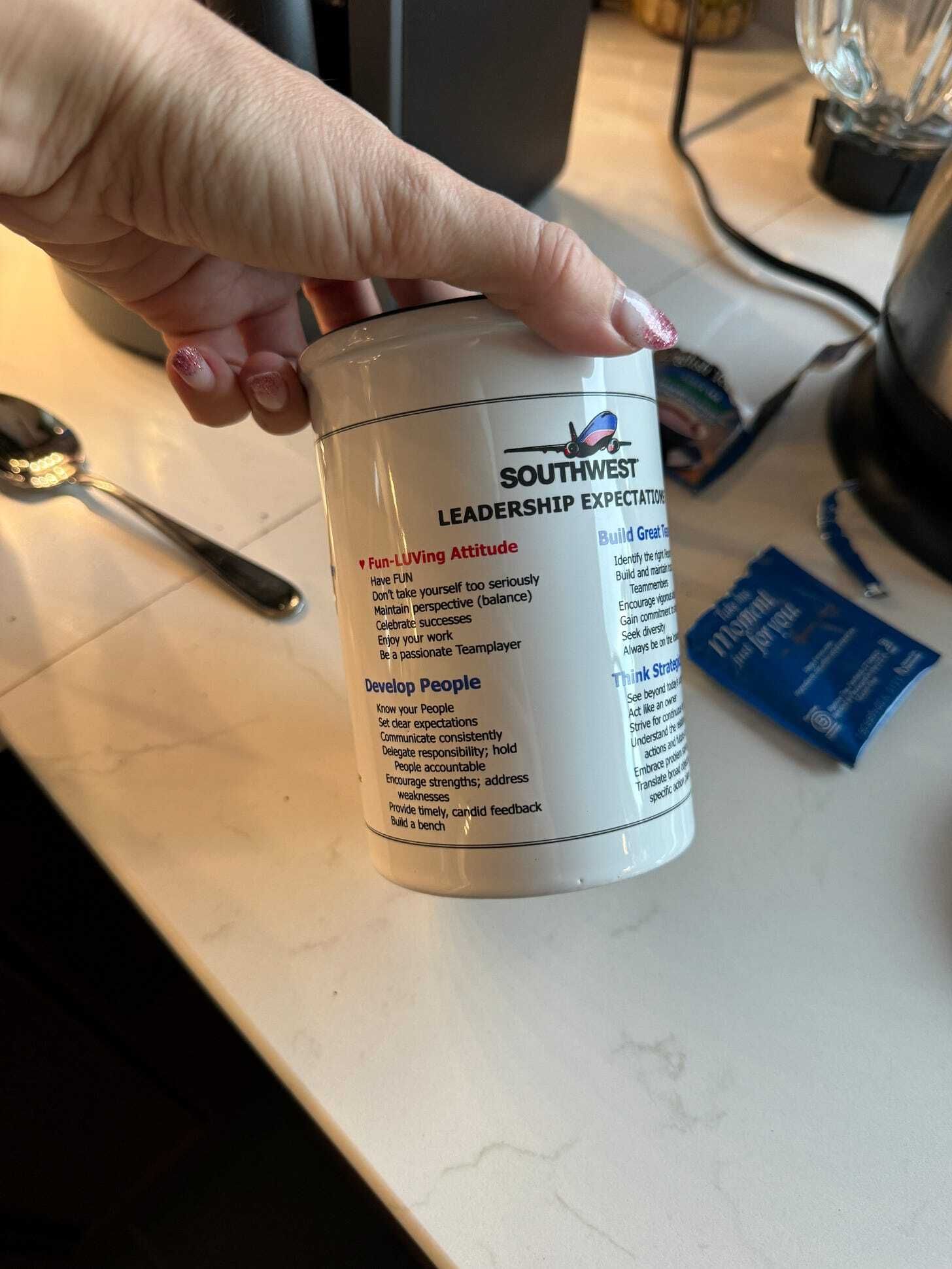
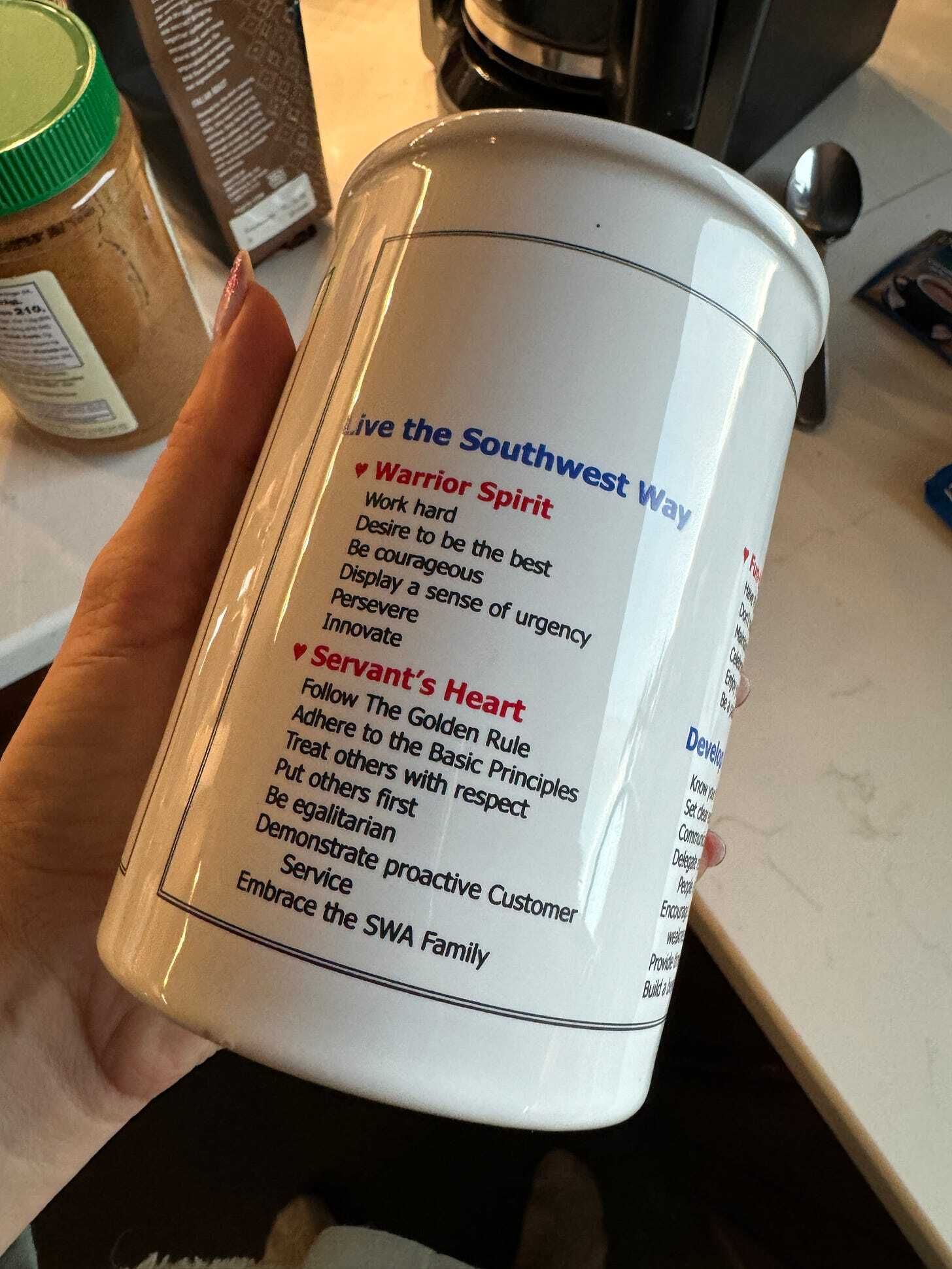
What Can We Learn from Southwest?
✅ Leadership shapes brand more than marketing does. Herb Kelleher was the brand. His vision, decisions, and principles made Southwest what it was.
✅ Simplicity is a superpower. One plane model, one class of service, one core mission. Keeping things simple gave Southwest a huge operational advantage.
✅ The power of building brand from the inside out. Southwest knew that brand isn’t dictated—it’s cultivated. Setting expectations, reinforcing values through internal communication, and empowering employees to be stewards of the brand is what made Southwest truly special.
What do you think? Is Southwest at risk of losing its brand edge (I say yes), or is this just smart business? Let’s discuss.
Brand news
Bandit opened a shop in LA. I feel like I write about running upstart Bandit a lot (here’s the deep dive), but that’s because they’re doing a lot worth talking about.
Loved this mix of people and place-based storytelling centered around tennis star Coco Gauff from New Balance.
This is more ‘agency news’ but I think Ollie Scott, CEO of creative recruitment firm UNKNOWN, has nailed the current moment with PE firms getting involved in agencies.
Matt Gattozzi from GOODO Studios here in Seattle released a killer talk on the worker revolution. This should be required listening for all creative leaders.
I had a lovely chat with Lindsay Rogers from The Brand Hunch podcast last week. I’ll share the episode once it drops!
Hot jobs
Some interesting in-house and agency gigs I’ve come across in my internet travels this week.
[In-house] Harry’s are hiring a Head of Brand Communications in New York.
[In-house] LEGO are hiring an Associate Creative Director in Copenhagen.
[Agency] Shepherd are hiring a paid research intern for a remote position 15 hours a week. Good people and a great opportunity for a budding strategist.
[Agency] Landor are hiring a Strategy Director in Japan. Cool opportunity for the right person.
Open call
Are you currently working on building a brand for your company but feeling like you're “throwing spaghetti against the wall” to see what sticks? If so, I’d love to hear your thoughts on two new ideas and products I’m testing.
If you have 30 minutes in the next two weeks for a 15-minute conversation, I’d really appreciate your feedback. As a thank you, I can offer book recommendations, discuss brand strategy, share insights on Substack, or anything else that might be helpful to you. If you’re interested, just reply to this email. ✨
Call me, beep me 📞
If you liked what you read, keep the party going by: